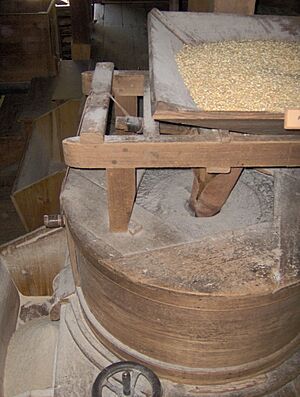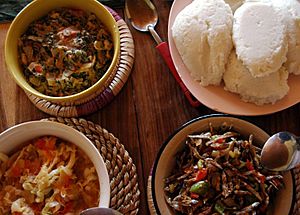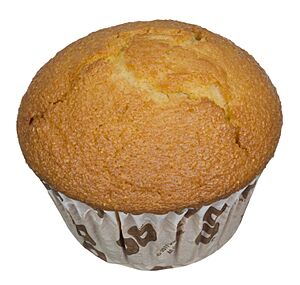Cornmeal facts for kids
Cornmeal is a coarse flour made by grinding dried corn. It's a popular food in many countries. Cornmeal can be ground to different textures: coarse, medium, or fine. However, it's not as fine as wheat flour. In Mexico, very finely ground cornmeal is called corn flour. When fine cornmeal is made from corn soaked in a special alkaline solution, it's called masa flour. This type is used to make foods like arepas, tamales, and tortillas. Boiled cornmeal is known as polenta in Italy. It's also a traditional dish and bread substitute in Romania.
Contents
Types of Cornmeal
There are several kinds of cornmeal, each with unique features:
Blue Cornmeal
Blue cornmeal has a light blue or violet color. It's made from whole blue corn and has a sweet taste. This cornmeal is usually ground to a fine or medium texture.
Yellow Cornmeal
Most common in the United States, steel-ground yellow cornmeal has almost all of its outer husk and germ removed. This helps it last longer, about a year, if stored properly in a cool, dry place. Stone-ground cornmeal keeps some of the husk and germ. This gives it more flavor and nutrients. It doesn't last as long as steel-ground, but it can be refrigerated to keep it fresh for many months.
White Cornmeal
White cornmeal, also called mielie-meal, is made from white corn. It's very popular in parts of Africa. It's also used a lot in the Southern United States to make cornbread.
Cornmeal Dishes Around the World
Cornmeal is used in many different ways across the globe. Here are some examples:
Caribbean Dishes
- Cornmeal porridge is a popular breakfast in Jamaica.
- Cou-cou is part of the national dish of Barbados. It's served with flying fish.
- Funche is a typical breakfast in Puerto Rico. It's cornmeal cooked with coconut milk, spices, and fruit.
- Funchi (also known as fungi/fungee) is a thick cornmeal mush. It's eaten in Curaçao and is part of the national dish of Antigua and Barbuda.
- Mayi moulen is a Haitian cornmeal dish. It's often cooked with fish or spinach.
East Asian Dishes
- Tie Bing (sticking bread) can be fluffy or flatbread-like. It's traditionally cooked around the edge of a large wok.
- Corn congee (棒子麵粥) is a porridge made from plain cornmeal. It's usually thinner than grits or polenta.
- Wo tou (窩頭 nest head) is a hollow cone-shaped cornbread. It's common in northern China and may include dried jujubes.
Sub-Saharan African Dishes
- Tuwo masara is a dish from Northern Nigeria.
- Mielie-meal or maize meal is a staple in Southern Africa.
- Nshima or bwali is a common food in Zambia and Malawi.
- Ugali is a staple food in the Great Lakes region. It's known as sima and posho in Uganda.
- Cornmeal is also used in fufu (foufou) in Central and West Africa.
European Dishes
- Arapash or harapash is an Albanian dish. It's similar to Romanian polenta, often with lamb or cheese.
- Kachamak (качамак) is a cornmeal dish from Bulgaria, North Macedonia, and Serbia.
- Mălai is the Romanian word for cornmeal itself. It's prepared as mămăligă.
- Polenta is a very well-known cornmeal dish. It's popular in southern Europe, especially Italy.
- Banusz is a Ukrainian dish. It's made from cornmeal with sour cream and toppings like pork rind or mushrooms.
Horn of Africa Dishes
- Soor is a cornmeal dish from Somalia.
- Cornmeal is also often added to injera or lahoh. These are flatbreads eaten in the Horn of Africa and Yemen.
East African Dishes
- Ugali is a staple food in Kenya, Uganda, and Tanzania.
- Cornmeal is used to make both Ugali and Uji in this region.
Indian Ocean Dishes
- Poudine maïs is a local dessert in Mauritius. It's made from cornmeal, milk, sugar, and spices. It's cooled and cut into triangular shapes.
South American Dishes

- Masarepa is soaked and cooked corn, ground into a fine flour. It's used in Venezuela and Colombia for arepas and empanadas.
- Polenta is also a typical dish in many South American countries. These include Argentina, Brazil, Paraguay, and Uruguay.
North American Dishes
- Masa or Masa harina is specially treated corn used for tamales and tortillas. It's common in Central America, Mexico, and South America.
- Cornmeal is used as a batter for fried foods like corn dogs.
- It's made into breads such as cornbread, hushpuppies, and jonnycakes.
- It serves as breading for fried or baked foods, like fried fish.
- Cornmeal is an ingredient in some breakfast cereals.
- It's used in cheese curl type snack foods, like Cheetos.
- It's found in corn chips such as Fritos.
- Cornmeal can be used as a release agent to stop breads and pizza from sticking to pans.
- It's the main ingredient for grits.
- It's made into a porridge called cornmeal mush. This mush is often sliced and grilled.
- In colonial times, cornmeal was known as "samp" and used as a kind of porridge.
South Asian Dishes
- Makki di roti is a traditional Punjabi bread. It's often eaten with saag in northern India and eastern Pakistan.
- In parts of northern India and Pakistan, ground corn flour is used to make thick bread. This bread can be eaten with curries or with yogurt.




